Discovering Dubai's most surprising corner – where Singapore meets Shoreditch
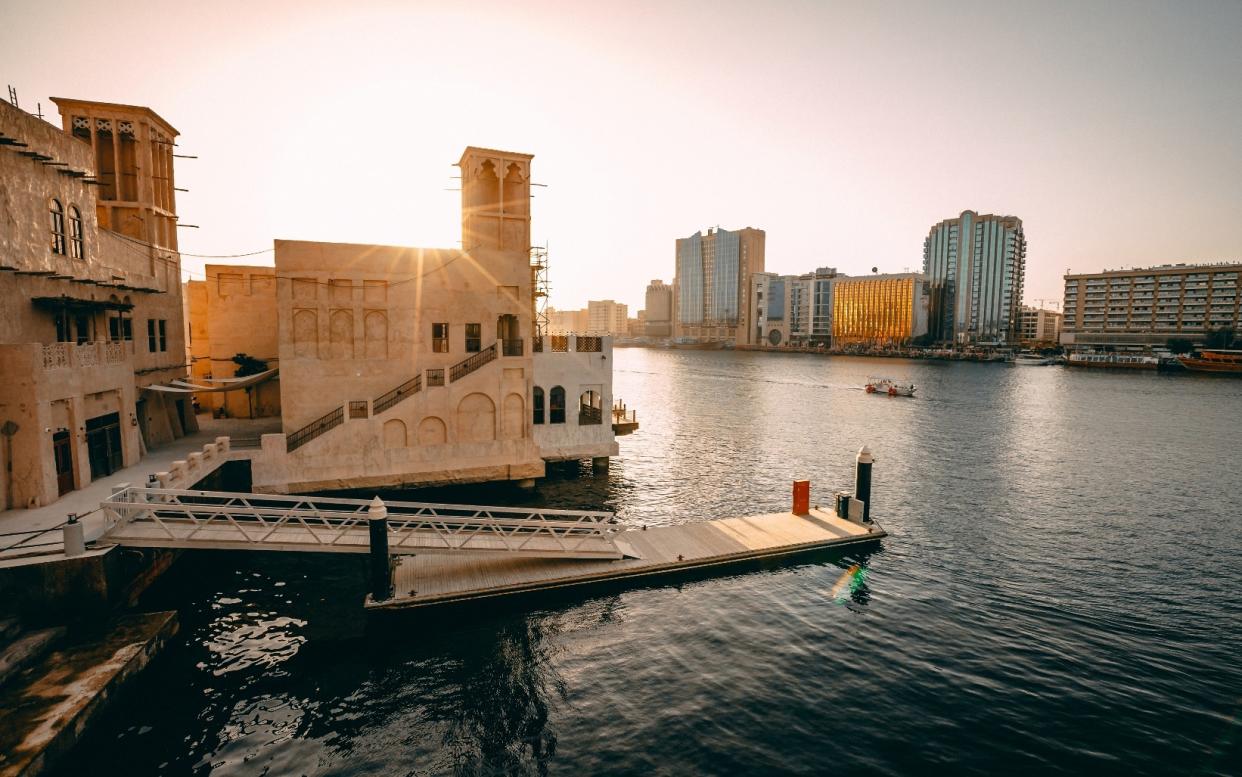
Brows knitted, my head swings from side to side looking for the source. Gradually, I become aware that I’m listening to the Lancashire lilt of my distant cousin over the sound system at Kim’s Singapore Seafood. Distant in every sense. She’s based in the UK where, I’m told, she briefly charmed Simon Cowell by performing a Preston-toned rendition of the Seventies hit YMCA on The X Factor. And now, just weeks later, a Singaporean restaurant is playing her cover version in their 21st century Dubai outpost. It’s a small world.
Though the venue seats 150 or so, I’m alone in Kim’s this late afternoon, enjoying a jade green leather booth and a pile of perfectly crisp fish skins all to myself. Surrounded by retro Asian murals, I hum along to the music. Simon was right; it really is a good tune.
Kim’s Place, as the flagship is called, began in Singapore in 1960. Back then it was a street food stall, but charismatic Mr Tan Kue Kim, in his flamboyant shirts and Rolex watch, knew his hokkien mee was destined for bigger things. Today, his son oversees the family’s growing business, while honouring his father’s culinary legacy, serving plates of the past to hungry consumers of nostalgia. It appears Dubai wants a slice of that pie.
From the terrace, I watch old wooden dhow boats chug across the vast width of Dubai Creek and I’m reminded of Suzy Wong’s Kowloon Bay. It’s fitting that this Middle Eastern neighbourhood is modelled on the same era. This is Al Seef, a regeneration of the creek’s south bank, paying homage to the Dubai of the mid-1900s. Deceptively dusty-looking cracked plaster bayt (houses), and the occasional barjeel (wind towers designed to pull in the breeze and cool the inhabitants below) mimic Emirati homes of yesteryear, which were once fashioned from coral stone and gypsum. Just as with the intricately carved wooden doors, the cracks and towers are decorative. Discreetly concealed within are fully air-conditioned Baskin-Robbins ice cream parlours and souvenir stores selling Arabian perfumes and pashminas.
Vendors are still setting up shop in this prime stretch of real estate. Its promenade, more than a mile long, runs along the creek to the genuinely historic district of Al Fahidi, with its fort dating back to 1787. As the oldest building in the emirate, the fort represents the heart of “Old Dubai”, and is home to Dubai Museum. Dubai Creek walks used to start around here before the Al Seef development extended the path.
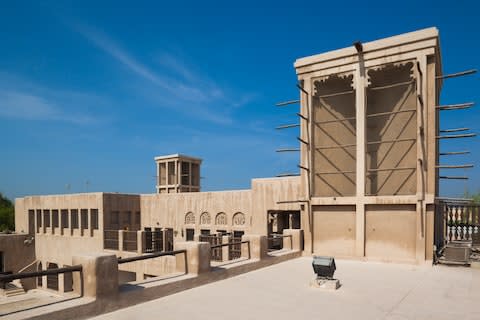
Today the area hosts tourists by the busload, although there are intermittent lulls. “Sometimes I have 70 customers at once, other times I get to nap,” laughs the shopkeeper at Zafarana dried goods store as I collect my 200g bag of lavender. It makes the most soothing tea and it’s a steal at AED30 (£6.25); my favourite tea house in Oxford charges twice as much for half the amount.
While exploring the area, I’m staying at the new four-star Al Seef Hotel, which facilitates this overnight immersion in the past. The rooms are like time machines, with scrupulous attention to historical detail. There are plenty of reproduction Bakelite rotary dial telephones and dolly light switches, brass twin-bell alarm clocks, copper sinks and distressed mirrors. And aged envelopes stamped with airmail franks are the finishing touches in this period drama. The tea- and coffee-making facilities are artfully concealed to fuel the illusion of authenticity, but my lavender can be brewed, rest assured.
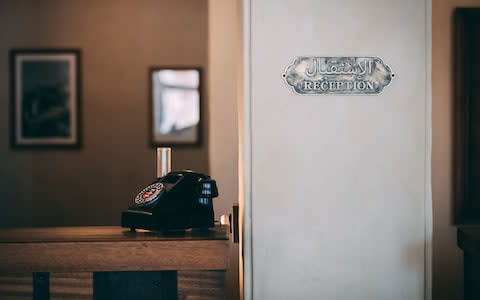
In the morning I discover Al Seef is a tale of two cities: Dubai in the 20th century and Dubai in the 21st. The modern half looks like a sanitised East London container park. This cubist landscape is home to more restaurants and Al Seef Hotel’s siblings, Zabeel House by Jumeirah Al Seef and Zabeel House MINI by Jumeirah, to give them their full and somewhat fussy titles, sure to confuse future clientele. The Zabeels are like twins, standing side by side; you can see they’re related but not identical. The 200-key four-star Zabeel House is taller, slightly more mature, sharing the same design ideals only with a more subdued monochrome palette. Three-star Zabeel House MINI is shorter, five storeys to seven, with an explosion of colours and slogans, not always employing correct grammar. As kids, MINI would have been the energetic tearaway vying for attention alongside his elder brother, the arty, shy but handsome emo.
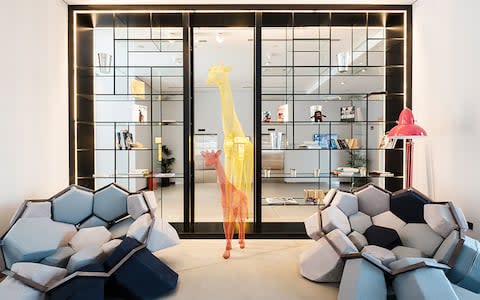
All three hotels are significant additions to the hospitality market in Dubai, not only for their forward-thinking design, but also for their affordability, being among Dubai’s new wave of three- and four-star sleeping arrangements that promise good value with Instagrammable backdrops. Doubles start from AED250 (£56) for Zabeel House MINI, AED350 (£74) for Zabeel House and AED400 (£85) for Al Seef Hotel. However, at these prices, some sacrifices must be made. To access pools and gyms, guests at Al Seef Hotel have to take a shuttle bus to the Zabeels, which feels like visiting the Joneses for a cup of sugar, despite Al Seef being the more expensive of the three properties. And so I find myself navigating this new neighbourhood from the exhilarating vantage point of Sol, Zabeel House’s rooftop pool bar, with world record-breaking structures Burj Khalifa and Dubai Frame towering on one side and, on the other, the low-level settlements of Dubai Creek, once the wealthy epicentre of this entrepôt, now dog-eared around the edges and fondly referred to as Old Dubai, like a family pet that’s had a good innings.
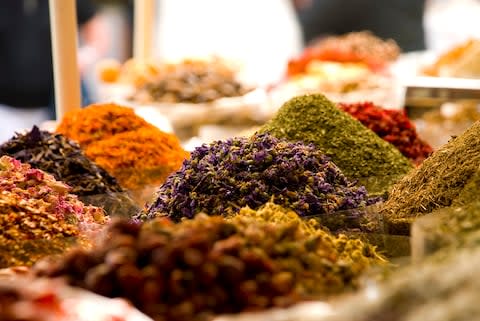
Al Seef isn’t the only development set to change all that. Breathing life back into this undervalued and often forgotten part of town is a game-changing initiative – and a contact has offered to give me a private preview ahead of the official opening. I stride through Al Seef and then Al Fahidi and the frenetic Textile Souq (“No, thanks, I don’t need a sarong/foot stool/genuine Louis Vuitton handbag”). I carry on beyond Bur Dubai abra station, resisting the chance to jump on a boat, and finally I arrive at my destination: Shindagha.
Previously home to a few tired museums, Shindagha reaches all the way to Port Rashid and the Arabian Gulf and has been quietly undergoing a transformation of epic proportions. The entire area will soon be an open-air museum, in turn populated with more museums built to the specifications of a map from the 1950s. As many as 20 traditional Emirati courtyard-houses will present different aspects of local history and culture. For the first time, ancestors’ intimate memories will be shared through installations, films, workshops and family heirlooms, all within one complex. The topics explored here will range from life at sea and the fruits of the land to beauty and food, with sections launching in phases from December 2018 up until 2020, the year of Dubai Expo.
Finally, the story of the Emirati will have a home – and it won’t be just for curious tourists. This institution aims to assert the essence of the Emirati and ensure their traditions are preserved for future generations at a time when locals are outnumbered by expatriates by four to one. In Dubai, youth has simply swapped cardamom-laced Arabian coffees and oud fumigations for Starbucks and Chanel.
On the subject of fragrance, I’m introduced to Perfume House, one of the first museums to be completed. Here I learn about Arabia’s love affair with cologne, and how, to an Emirati, grief smells like camphor and roses, the oil blend used to anoint the dead. I discover how the snaking smoke from incense burners is applied in wafts to the abaya and kandura, and that certain scents carry specific meanings. As famously hospitable as they are, when an Emirati decides that it’s time for you to leave their home, they will diffuse a scent to say maasalaamah, or good-bye. And with that, I feel my privileged encounter at the museum has come to an end.
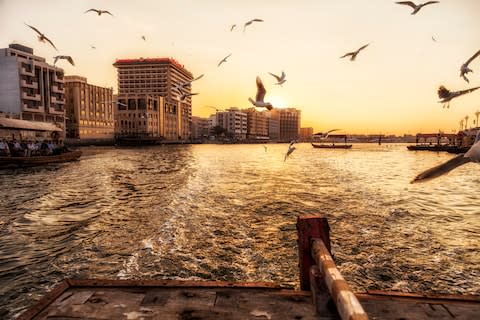
A week later, I’m back in Old Dubai, and despite its ongoing rejuvenation, it still suits the name with its renewed grasp on the past. This evening, I’m attending a red-carpet event onboard the QE2. Docked in the otherwise cheerlessly industrial Port Rashid, the iconic ocean liner towers above us, her freshly painted exterior forgetting her age. In her lifetime, she’s completed 1,400 voyages, sailed six million nautical miles and carried more than two million passengers, some of them British soldiers returning from the Falkland’s War.
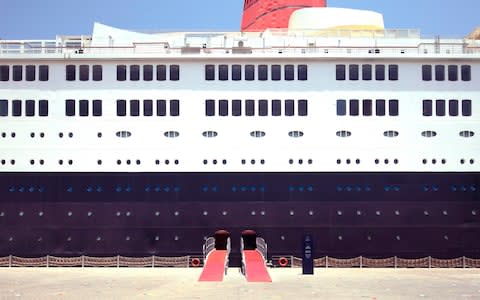
Tonight, we’re celebrating the launch of Theatre by QE2, with programming by my friend Maxine Redding, a Geordie by birth, but one of Dubai’s devout expats since childhood. I’m grateful Dubai chose to spend some of its wealth on rescuing this grand dame from the scrap yard and it’s a challenge not to succumb to sentimentality on seeing her restored to her former glory. Performers hail from all over the world, and many are past contestants on television talent shows, the modern-day reincarnation of the old-school variety performances enjoyed by our parents, proving that tastes haven’t shifted that much, despite the advent of Snapchat and YouTube.
I hear on the social media grapevine that my cousin didn’t make it through to the next round of trials on The X Factor, but perhaps, just maybe, I’ll see her perform right here on this storied ship someday, in a land where anything can happen.
Five ways to discover Old Dubai
1. Walk the Creek
Take a stroll just before dawn, when sailors from the old Silk Route will probably be enjoying early morning group yoga sessions; or wander in the eveningt, when the souk lights and illuminated sail boats decorate the black waters of the creek with liquid gems. meraas.com/en/destinations/al-seef
2. Breakfast at Saba’a
You will never forget Emirati breakfasts after devouring baidh o’tomat (buttery eggs scrambled with sweet tomatoes) and chebab (golden pancakes, loaded with saffron, light with air bubbles, drenched in date syrup). AED75 (£16), jumeirah.com
3. Bend Your Mind at the Museum of Illusions
After the first branch opened in Zagreb in 2015, several more followed, including this one. True to form, Dubai’s has the largest collection of optical illusions in the world. Tickets AED80 (£17), museumofillusions.ae
4. Get Happy at Kim’s Singapore Seafood
It’s happy hour all night at Kim’s with two-for-one cocktails halving the AED60 (£13) price tag from 6pm until closing. Try Gardens by the Bay (Absolut Citron muddled with melon liqueur, coriander, pineapple and lemon) and follow up with a plate of the hokkien mee noodles that started it all. Mains from AED75 (£16), 009714 370 8288
5. Have Shisha at Skafos
Book ahead for a table at Zabeel House’s Skafos shisha terrace, an aromatic and ambient deck projecting over Dubai Creek; it’s in high demand after dark. zabeelhouse.com/alseef
More information at visitdubai.com

